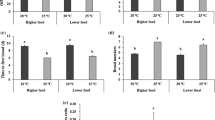Summary
Instantaneous gross growth efficiencies ofDaphnia magna were determined at different temperatures. An optimum was found at 9°C while at temperatures above 22°C negative efficiencies were found.
Similar content being viewed by others
References
BANTA, A.M., 1939. Studies on the physiology, genetics, and evolution of some cladocera. Carnegie Institution of Washington. 285 p.
BERG, K., 1931. Studies on the genusDaphnia O.F. Muller. Vidensk Medd. dansk naturh. Foren. Kbh., 92: 1–222.
FOX, H.M., B.M. GILCHRIST and E.A. PHEAR, 1951. Functions of haemoglobin inDaphnia. Proc. Roy. Soc. (B), 138: 514–528.
GREEN, J., 1965. Growth, size and reproduction in,Daphnia. Proc. Zool. Soc. London, 126: 173–204.
HEISEY, D., and K.G. Porter, 1977. The effect of ambient oxygen concentration on filtering and respiration rates ofDaphnia galeata mendotae andDaphnia magna. Limnol. Oceanogr., 22:839–846.
HOSHI, T., and T. YAJIMA, 1970. Studies on physiology and ecology of plankton. XXIV. Possible role of blood haemoglobin induced by low oxygen culture in the respiration ofDaphnia magna. Science Rep. Niigata Univ. Ser. D (Biology), 7: 107–115.
JANISCH, E., 1938. Das klimatische Optimum der Nonnenraupe. Mitt. Forstwirtsch. Forstwiss., 9: 372–386.
JOHNSON, D.S., 1952. A thermal race ofDaphnia atkinsoni Baird, and its distributional significance. J. anim. Ecol., 21: 118–119.
KENDALL, M.G., 1955. Rank correlation methods. Griffin. 160 p.
KERSTING, K., 1978. Growth efficiency ofDaphnia magna. I. The effect of food concentration. Hydrobiol. Bull., 12: 3–21.
KERSTING, K., and W. VAN DER LEEUW, 1976. The use of the Coulter Counter for measuring the feeding rates ofDaphnia magna. Hydrobiologia, 49: 233–237.
KERSTING, K., and C. VAN DER LEEUW-LEEGWATER, 1976. Effect of food concentration on the respiration ofDaphnia magna. Hydrobiologia, 49: 137–142.
KIBBY, H.V., 1971a. Energetics and population dynamics ofDiaptomus gracilis. Ecol. Monogr., 41: 311–327.
KIBBY, H.V., 1971b. Effect of temperature on the feeding behavior ofDaphnia rosea. Limnol. Oceanogr., 16: 580–581.
LAMPERT, W., 1977a. Studies on the carbon balance ofDaphnia pulex de Geer as related to environmental conditions. II. The dependence of carbon assimilation on animal size, temperature, food concentration and diet species. Arch. Hydrobiol./Suppl., 48: 310–335.
LAMPERT, W., 1977b. Studies on the carbon balance ofDaphnia pulex de Geer as related to environmental conditions. III. Production and production efficiency. Arch. Hydrobiol./Suppl., 48: 336–360.
McARTHUR, J.W., and W.H.T. BAILLIE, 1929. Metabolic activity and duration of life. I. Influence of temperature on longevity inDaphnia magna. J. exp. Zool., 53: 221–242.
McMAHON, J.W., 1965. Some physical factors influencing the feeding behaviour of Daphnia magna Straus. Can. J. Zool., 43: 603–611.
McMAHON, J.W., and F.H. RIGLER, 1963. Mechanisms regulating the feeding rate ofDaphnia magna Straus. Can. J. Zool., 41: 321–332.
McMAHON, J.W., and F.H. RIGLER, 1965. Feeding rate ofDaphnia magna Straus in different foods labeled with radioactive phosphorus. Limnol. Oceanogr., 10: 105–113.
PRATT, D.M., 1943. Analysis of population development inDaphnia at different temperatures. Biol. Bull., 85: 116–141.
PRECHT, H., 1949. Die Temperaturabhängigkeit van Lebensprozessen. Z. Naturforsch., 4b: 26–35.
PRUS, T., 1975. Bioenergetic budgets and balances. In: W. Grozinski, R. Z. Klekowski and A. Duncan (eds.), Methods for ecological bioenergetics. IBP Handbook, 24: 263–272.
RINGELBERG, J., 1973. Parameter dependent (temperature) tolerance levels and the influence of the complexity of the biological system. Hydrobiol. Bull., 7: 106–115.
SCHINDLER, D.W., 1968. Feeding, assimilation and respiration rates ofDaphnia magna under various environmental conditions and their relation to production estimates. J. Anim. Ecol., 37: 369–385.
SCHWERDTFEGER, F., 1963. Ökologie der Tiere. I. Autökologie. Verlag Paul Parey. 461 p.
SCOURFIELD, B. J., and J. P. HARDING, 1958. A key to the British species of freshwater Cladocera. Freshwater Biological Association. 52 p.
SOKAL, R.R., and F.J. Rohlf, 1969. Biometry. W.H. Freeman. 776 p.
Author information
Authors and Affiliations
Rights and permissions
About this article
Cite this article
Kersting, K. The growth efficiency ofDaphnia magna II. The effect of temperature. Hydrobiological Bulletin 12, 99–106 (1978). https://doi.org/10.1007/BF02260710
Issue Date:
DOI: https://doi.org/10.1007/BF02260710




